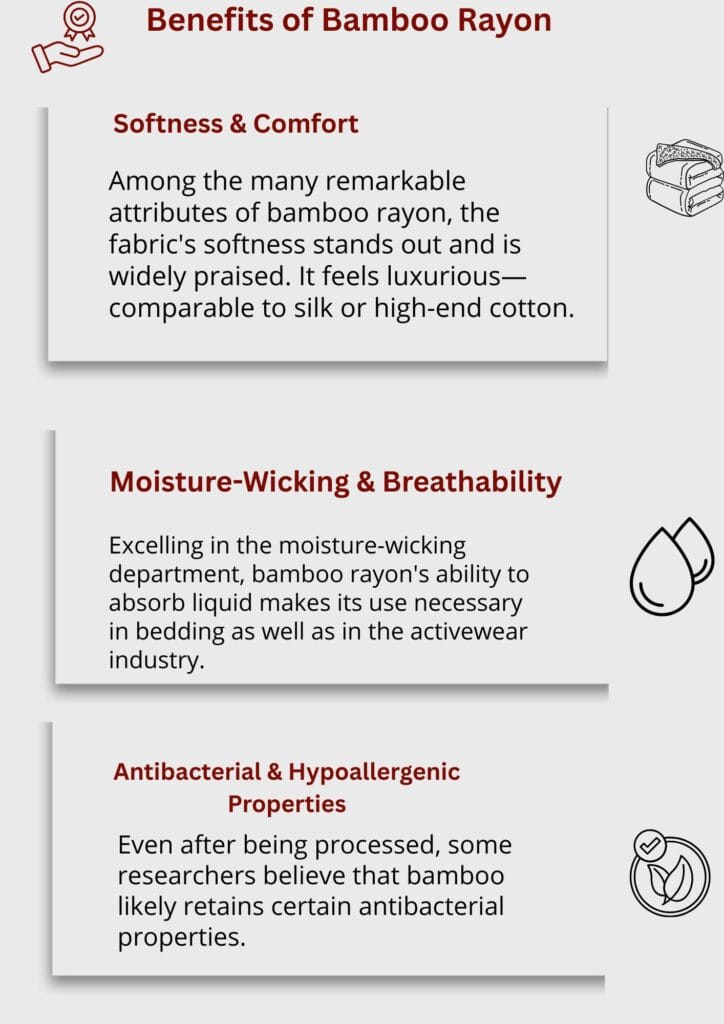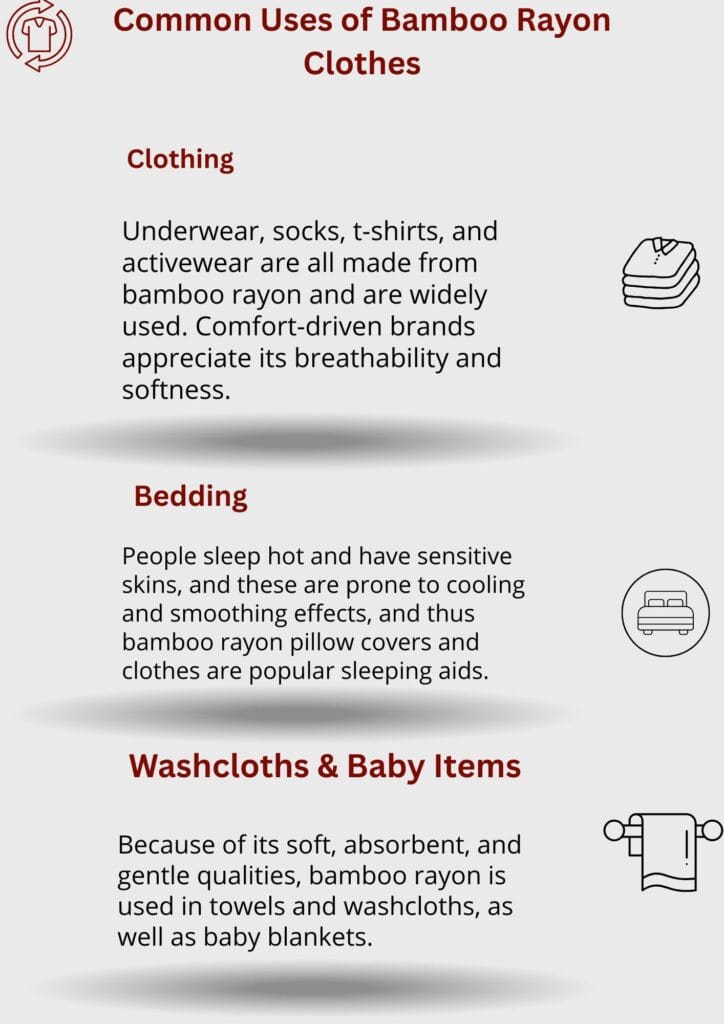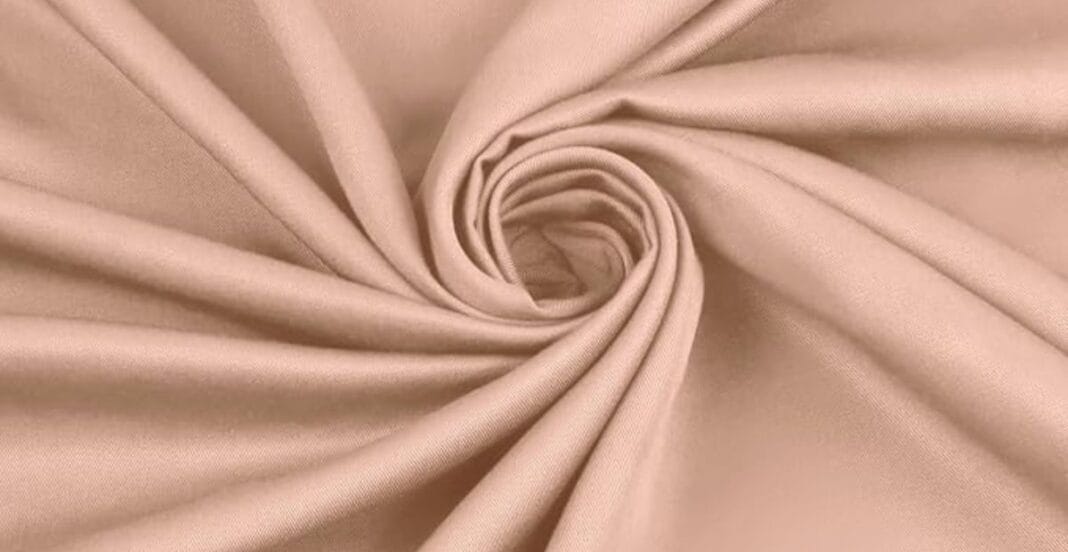Introduction
What Is Bamboo Rayon?
Bamboo rayon is categorized as a semi-synthetic fabric, as it is created from the regenerative processes of plants’ cellulose. The bamboo undergoes chemical processes to convert its pulp into soft and wearable fibers.
While bamboo is the source material, this fabric does not preserve the shape or structure of the bamboo fibers. The final product is soft and silky, resembling traditional rayon closely.
How It Differs from Other Bamboo Fabrics
There are different types of bamboo textiles, but one cannot assume they are all the same. Bamboo rayon goes through chemical processes, while linen undergoes different, more gentle processes, retaining more natural bamboo traits.
While bamboo linen is more eco-friendly, it is also coarser. In contrast, bamboo rayon’s smoothness makes it more comfortable and suitable for clothing and bedding.
Brief History and Popularity
Bamboo rayon became widely available in the early 2000s when people started caring about sustainable materials. The branding paired with the soft texture drew many first-time users.
Since then, it has become widely used for Baby products and home textiles. However, people are concerned it overuses resources, making the manufacturing side questionable.
How Bamboo Rayon Is Made
The Chemical Process (Viscose Method)
The viscose process is the most popular method for producing. In this technique, bamboo is shredded into pulp and then the cellulose is dissolved using sodium hydroxide and carbon disulfide.
Afterward, spinnerets are used to produce fibers from the liquid. These fibers are then put into a mixture of sulfuric acid, where they harden and are spun into yarns.
Though effective, this procedure raises concerns regarding eco-friendliness due to the harmful chemicals used.
Comparison with Other Rayon Types
Bamboo rayon is analogous to viscose generated from wood pulp. Modal and lyocell are regarded to be safe and environmentally more responsible.
With less chemical waste, modal is an improved form of rayon. The most eco-friendly option, lyocell (TENCEL™), employs a closed-loop system that recycles 99% of solvents.
Bamboo rayon, on the other hand, is more uncontrolled and polluting compared to these options.
Environmental Concerns
Although bamboo absorbs CO₂ and grows quickly, the production process counteracts most of these advantages. Workers and the ecosystem are endangered with hazardous rayon chemicals during production.
Factories lacking regulation often discharge wastewater directly into water bodies without treatment, polluting these ecosystems.
Bamboo Rayon vs Other Fabrics
Bamboo Rayon vs Cotton
While cotton is a common fabric, its cultivation requires a lot of water and pesticides. Bamboo rayon has a lower water requirement compared to cotton and its chemicals used in processing are higher.
Outperforms cotton in breathability and softness. On the other hand, cotton wins in durability and is often preferred for long-lasting items.
Bamboo Rayon vs Polyester
Polyester is a synthetic material made from petroleum. It’s cheap and durable, but does not rot naturally. Semi-synthetic bamboo rayon is more eco-friendly, as it is biodegradable in certain conditions.
Bamboo rayon blows polyester out of the water for comfort. It’s cooler, softer, and does not hold odors like polyester does.
Bamboo Rayon vs Organic Bamboo Fabric
Bamboo linen, or organic bamboo fabric, is the result of bamboo being processed mechanically. It tends to be the most unrefined form of bamboo fiber and thus, more coarse and expensive.
Bamboo rayon undergoes a more industrialized process but feels better against the skin, while the organic version is softer but comes with a more complicated and eco-friendly process. These reasons are what set the two apart while shopping.
Benefits of Bamboo Rayon

Softness & Comfort
Among the many remarkable attributes of bamboo rayon, the fabric’s softness stands out and is widely praised. It feels luxurious—comparable to silk or high-end cotton.
Other benefits of bamboo rayon include being gentler than most materials which makes it a great choice for people who suffer from skin allergies. It does not rub against the skin and can slide over the body comfortably.
Moisture-Wicking & Breathability
Excelling in the moisture-wicking department, bamboo rayon’s ability to absorb liquid makes its use necessary in bedding as well as in the activewear industry.
Additionally, the fabric breathable. During hot weather, it can allow air to pass freely, preventing overheating.
Antibacterial & Hypoallergenic Properties
Even after being processed, some researchers believe that bamboo likely retains certain antibacterial properties. These can help discourage odor and skin discomfort.
In comparison to synthetic products, bamboo rayon fabric has fewer allergic reactions which is, surprisingly, beneficial when paired with this hypoallergenic claim.
Biodegradability
Bamboo rayon can biodegrade in the right composting conditions unlike polyester, making it a more sustainable choice in the long-run—provided it is disposed of properly.
Not all bamboo rayon breaks down equally though, some chemical additives may hinder the process.
Drawbacks & Controversies
Issues with the Viscose Method of Production
The production system poses the biggest concern. The viscose method of bamboo rayon’s fabrication uses toxic solvents that can be disastrous to the environment without proper management.
Factories have also been reported to contaminate rivers and have health issues with their workers for textiles.
False “Eco-Friendly” Labeling
The majority of brands claim to market bamboo rayon eco-friendly, but do not mention the chemicals used in processing it.
The true fabric (linen) is rare, making it easier for companies to mislead consumers about its sustainability.
Pill or Deflator Bamboo Rayon
Bamboo rayon soft fabric does not last as long as polyester and cotton. Hot water can cause it to shrink; frequent washing can lead to pilling.
Follow the guidebook to delay its lifespan loss.
Common Uses of Bamboo Rayon Clothes

Clothing
Underwear, socks, t-shirts, and activewear are all made from bamboo rayon and are widely used. Comfort-driven brands appreciate its breathability and softness.
It’s also used widely in maternity and baby clothes because they are hypoallergenic.
Bedding
People sleep hot and have sensitive skins, and these are prone to cooling and smoothing effects, and thus bamboo rayon pillow covers and clothes are popular sleeping aids.
These fabrics have a slight bit of shimmer and flows well, which gives it a touch of elegance.
Washcloths & Baby Items
Because of its soft, absorbent, and gentle qualities, bamboo rayon is used in towels and washcloths, as well as baby blankets. For many parents, bamboo rayon is favored for its antibacterial properties and softness.
Its quick drying ability makes it practical for everyday use.
Is Bamboo Rayon Eco-Friendly?
Debate on “Greenwashing”
Most companies that make bamboo rayon products market them as sustainable. In cases that involve chemical processing, the marketing claim becomes misleading.
In the case where the manufacturing process is not transparent and responsibly managed, the claimed environmental benefits of bamboo rayon are questionable.
Certifications To Look Out For
Look for trusted certifications like OEKO-TEX, FSC, or EcoCert, which guarantee that the fabric is free of harmful substances and produced responsibly.
These certifications are helpful in allowing consumers to make informed and ethical purchases.
Comparison with Lyocell Bamboo Fabric
Lyocell (often branded as TENCEL™) made from bamboo is a greener alternative. It utilizes a closed-loop system that recycles water and solvents.
While it is more expensive, it strikes a better balance between comfort and sustainability.
How to Care for Bamboo Rayon Fabric
Care Instructions for Washing and Drying
To ensure that bamboo rayon retains its quality, launder it on a gentle cycle using cold water and mild detergents free of bleach.
Keep the shape of the fabric by not twisting or wringing it.
Preventing Shrinkage and Damage
Air drying is optimal, but using a low heat dryer setting is acceptable. Bamboo rayon shrinks and loses shape when exposed to high temperatures.
If necessary, ironing should only be done on low heat. Avoid using any form of fabric softeners.
Buying Guides for Bamboo Rayon Fabrics
Trusted Retailers for Bamboo Rayon Clothing and Bedding
There are multiple brands offering bamboo rayon products. Make sure to research the brand to check if they have ethical sourcing as well as certifications.
Boody, Cariloha, and Ettitude are trusted brands known for their quality and ethical business practices. (Mention affiliate links if you’re using them.)
Comparison of Prices to other Rayons
Bamboo rayon is casually priced. It comes at a greater price than polyester but lower than organic cotton and TENCEL™. Its eco-friendly value and delightful softness makes it worth the price for most.
Conclusion
So what exactly is bamboo rayon? It is a chemical processed fabric made from bamboo pulp and turns out to be a soft and breathable fabric. It does have a lot of advantages among which are comfort and biodegradability but most of the time, overstated claims are made about its sustainability.
Make informed decisions looking for eco-certifications and understanding the difference between bamboo rayon and true bamboo fabric. Make smart choices and take charge of your responsibility.
FAQs
No, bamboo rayon undergoes chemical processing. Bamboo fabric, also referred to as bamboo linen, is rare and categorized as less common as it undergoes different mechanical processes.
No, the fabric itself is not toxic, however, its production and manufacturing processes involve toxic chemicals. Always look for safe certification marks when making a purchase.
If washed in hot water or dried at high heat, then yes. Always follow the instructions on garment care.
Bamboo does well in softness and moisture-wicking. But compared to cotton it lacks in durability and ease of maintenance.
It is affordable due to mass production and chemical processing, but those “cheaper” rates always lack in sustainable practices.


